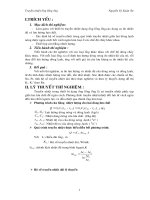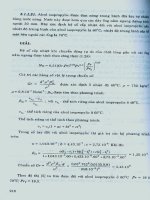THUYẾT TRÌNH THIẾT BỊ BOILERS
Bạn đang xem bản rút gọn của tài liệu. Xem và tải ngay bản đầy đủ của tài liệu tại đây (612.96 KB, 45 trang )
2 Boilers
Syllabus
•
•
•
•
Boiler Types, Combustion in boilers
Performances evaluation of boilers, Analysis of losses
Feed water treatment, Blow down
Energy conservation opportunities.
2.1 Introduction to Boiler
•
•
It is an enclosed Pressure Vessel
•
Process: Evaporation
•
Steam volume increases to 1,600 times
from water and produces tremendous
force
Care is must to avoid explosion.
•
Heat generated by Combustion of
Fuel is transferred to water to
become steam
What is a boiler?
Boiler Specification
•
Boiler Make & Year
•
MCR(Maximum Continuous Rating) :10TPH (F & A 100oC)
•
Rated Working Pressure
:10.54 kg/cm2(g)
•
Type of Boiler
: 3 Pass Fire tube
•
•
Fuel Fired
Heating surface
:XYZ & 2003
: Fuel Oil
: M2
2.2 Boiler Systems
Water treatment system
Feed water system
Steam System
Blow down system
Fuel supply system
Air Supply system
Flue gas system
2.3 Boiler Types and Classifications
•
Fire in tube or Hot gas through tubes and boiler feed
water in shell side
•
Fire Tubes submerged in water
Application
•
Used for small steam capacities
( upto 25T/hr and 17.5kg/cm2
Merits
•
•
•
Low Capital Cost and fuel Efficient (82%)
Accepts wide & load fluctuations
Packaged Boiler
Fire Tube Boiler
•
•
Boiler Types and Classifications
Water Tube Boiler
Water flow through tubes
Water Tubes surrounded by hot gas
Application
•
•
Used for Power Plants
Steam capacities range from 4.5- 120 t/hr
Characteristics
•
•
High Capital Cost
•
•
Demands more controls
Used for high pressure high capacity steam
boiler
Calls for very stringent water quality
•
Package boilers are generally of shell
type with fire tube design
More number of passes-so more heat
transfer
Large number of small diameter tubes
leading to good convective heat
transfer.
Higher thermal efficiency
Packaged Boiler
Chain Grate or Traveling Grate Stoker Boiler
Coal is fed on one end
of a moving steel chain
grate
Ash drops off at end
Coal grate controls rate
of coal feed into
furnace by controlling
the thickness of the
fuel bed.
Coal must be uniform
in size as large lumps will
not burn out completely
Spreader Stoker Boiler
Uses both suspension and grate
burning
Coal fed continuously over burning
coal bed
Coal fines burn in suspension and
larger coal pieces burn on
grate
Good flexibility to
meet changing load requirements
Preferred over other type of stokers
in industrial application
Pulverized Fuel Boiler
Coal is pulverised to a fine powder, so that less than 2% is +300
microns, and 70-75% is below 75 microns.
Coal is blown with part of the combustion air into the boiler plant
through a series of burner nozzles.
• Combustion temperatures from
1300-1700°C
• Particle residence time in the
boiler is 2-5 seconds
• Most popular system for firing
pulverized coal is the tangential
firing using four burners corner to
corner to create a fire ball at the
center of the furnace
Tangential firing
Pulverized Fuel Boiler (Contd..)
Advantages
•
Its ability to burn all ranks of coal from anthracitic to lignitic, and it permits
combination firing (i.e., can use coal, oil and gas in same burner). Because
of these advantages, there is widespread use of pulverized coal furnaces.
Disadvantages
•
•
High power demand for pulverizing
Requires more maintenance, flyash erosion and pollution complicate unit
operation
Fluidized bed Combustion (FBC) boiler
Distributed air is passed upward through a bed of solid particles
The particles are undisturbed at low velocity.As air velocity is increased,
a stage is reached when the particles are suspended in the air
Further,
increase
in
velocity gives rise to
bubble formation, vigorous
turbulence
and
rapid
mixing and the bed is said
to be fluidized.
Coal is fed continuously in
to a hot air agitated
refractory sand bed, the
coal will burn rapidly and
the bed attains a uniform
temperature
Fluidised Bed Combustion
Fluidized-bed boiler (Contd..)
Advantages :
•
Higher rates of heat transfer between combustion process and boiler tubes (thus
•
combustion temperature 850oC is lower than in a conventional furnace. The lower
•
In addition, the limestone (CaCO ) and dolomite (MgCO ) react with SO to form
3
3
2
calcium and magnesium sulfides, respectively, solids which do not escape up the
reduced furnace area and size required),
furnace temperatures means reduced NO production.
x
stack; This means the plant can easily use high sulfur coal.
•
Fuel Flexibility: Multi fuel firing
2.4 Performance Evaluation of Boilers
There are two methods of assessing boiler efficiency.
1) The Direct Method: Where the energy gain of the working
fluid (water and steam) is compared with the energy content of the
boiler fuel.
2) The Indirect Method: Where the efficiency is the difference
between the losses and the energy input.
Boiler Efficiency
Evaluation Method
1. Direct Method
2. Indirect
Method
Efficiency Calculation by Direct
Method
Example:
Type of boiler: Coal fired Boiler
Heat input data
Qty of coal consumed
:1.8 TPH
GCV of coal
:3200K.Cal/kg
Heat output data
•
•
•
•
•
Qty of steam gen
: 8 TPH
Steam pr/temp:10 kg/cm2(g)/1800C
Enthalpy of steam(sat) at 10 kg/cm2(g) pressure
Feed water temperature : 850 C
Enthalpy of feed water
: 85 K.Cal/kg
Find out the Find efficiency ?
Find out the Evaporation Ratio?
:665 K.Cal/kg
Boiler efficiency (η): = Q x (H – h) x 100
(q x GCV)
Where Q = Quantity of steam generated per hour (kg/hr)
H = Enthalpy of saturated steam (kcal/kg)
h = Enthalpy of feed water (kcal/kg)
q = Quantity of fuel used per hour (kg/hr)
GCV = Gross calorific value of the fuel (kcal/kg)
Boiler efficiency (η)=
8 TPH x1000Kg/Tx (665–85) x 100
1.8 TPH x 1000Kg/T x 3200
= 80.0%
Evaporation Ratio
= 8 Tonne of steam/1.8 Ton of coal
= 4.4
What are the losses that occur in a boiler?
Steam Output
6. Surface loss
1. Dry Flue gas loss
2. H2 loss
3. Moisture in fuel
4. Moisture in air
5. CO loss
7. Fly ash loss
Fuel Input, 100%
Boiler
Flue gas
Air
8. Bottom ash loss
Efficiency
(by In Direct Method)
= 100 – (1+2+3+4+5+6+7+8)
Example:
The following are the data collected for a typical oil fired boiler. Find out the efficiency of the
boiler by indirect method and Boiler Evaporation ratio.
Ultimate analysis of Oil
C : 84.0 %
H2: 12.0 %
S: 3.0 %
O2: 1.0 %
GCV of Oil
: 10200 kcal/kg
Steam Generation Pressure
: 7kg/cm2(g)-saturated
Enthalpy of steam
: 660 kCal/kg
Feed water temperature
: 60oC
Percentage of Oxygen in flue gas: 7
Percentage of CO2
in flue gas: 11
Flue gas temperature (Tf)
: 220 0C
Ambient temperature (Ta)
: 27 0C
Humidity of air
: 0.018 kg/kg of dry air
Solution
Step-1: Find the theoretical air requirement
[(11 .6 x C ) + {34.8 x ( H
2
− O2 / 8)} + (4.35 x S )] / 100
= kg/kg of oil
=[(11.6 x 84) + [{34.8 x (12 – 1/8)} + (4.35 x 3)]/100 kg/kg of oil
=14 kg of air/kg of oil
Step-2: Find the %Excess air supplied7%
O2 %
x100
21 − O2%
x100
Excess air supplied (EA) =
= 21 − 7
= 50%
Step-3: Find the Actual mass of air supplied
Actual mass of air supplied /kg of fuel = [ 1 + EA/100] x Theoritical Air
(AAS)
= [1 + 50/100] x 14
= 1.5 x 14
= 21 kg of air/kg of oil
Step-4: Estimation of all losses
i. Dry flue gas loss
Percentage heat loss due to dry flue gas =
m x C p x (T f − Ta )
GCV of fuel
x 100
m= mass of CO2 + mass of SO2 + mass of N2 + mass of O2
0.84 x 44 0.03 x 64 21 x 77
23
m=
+
+
+ (21 − 14) x
12
32
100
100
m
=
21 kg / kg of oil
21 x 0.23 x (220 − 27)
x 100
10200
= 9.14 %
Alternatively a simple method can be used for determining the
dry flue gas loss as given below.
m x C p x (T f − Ta )
x 100
a) Percentage heat loss due to dry flue gas =
GCV of fuel
Total mass of flue gas (m) = mass of actual air supplied + mass of
fuel supplied
= 21 + 1=22
22 x 0.23 x ( 220 − 27)
x 100 = 9.57%
%Dry flue gas loss =
10200
ii. Heat loss due to evaporation of water formed due to H2 in fuel
9 x H 2 x {584 + C p (Tf - Ta )}
=
GCV of fuel
Where, H2 – percentage of H2 in fuel
=
x 100
9 x 12 x {584 + 0.45 (220 - 27 )}
x 100
10200
= 7.10%
iii. Heat loss due to moisture present in air
AAS x humidity x C p x (T f − Ta )
x 100
=
GCV of fuel
=
21 x 0.018 x 0.45 x (220 − 27)
x 100
10200
= 0.322
iv Heat loss due to radiation and other unaccounted losses
For a small boiler it is estimated to be 2%
Boiler Efficiency
i. Heat loss due to dry flue gas
: 9.14%
ii. Heat loss due to evaporation of water formed due to H2 in fuel
: 7.10 %
iii. Heat loss due to moisture present in air
iv. Heat loss due to radiation and other unaccounted loss
: 2%
: 0.322 %
Boiler Efficiency = 100- [9.14+7.10+0.322+2]
= 100 – 18.56 = 81 (app)
Evaporation Ratio = Heat utilised for steam generation/Heat addition to the steam
= 10200 x 0.81/ (660-60)
= 14.11
2.5 Why Boiler Blow Down ?
When water evaporates Dissolved solids gets concentrated
and Solids precipitates on tubes. Reduces the heat transfer rate









